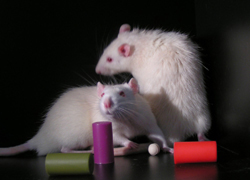Archived Content
The National Institute of Mental Health archives materials that are over 4 years old and no longer being updated. The content on this page is provided for historical reference purposes only and may not reflect current knowledge or information.
Tired Neurons Caught Nodding Off in Sleep-deprived Rats
Performance Decline Belies Seeming Wakefulness – NIH-funded Study
• Press Release
A new study in rats is shedding light on how sleep-deprived lifestyles might impair functioning without people realizing it. The more rats are sleep-deprived, the more some of their neurons take catnaps — with consequent declines in task performance. Even though the animals are awake and active, brainwave measures reveal that scattered groups of neurons in the thinking part of their brain, or cortex, are briefly falling asleep, scientists funded by the National Institutes of Health have discovered.
"Such tired neurons in an awake brain may be responsible for the attention lapses, poor judgment, mistake-proneness and irritability that we experience when we haven't had enough sleep, yet don't feel particularly sleepy," explained Giulio Tononi, M.D., Ph.D., of the University of Wisconsin-Madison. "Strikingly, in the sleep-deprived brain, subsets of neurons go offline in one cortex area but not in another — or even in one part of an area and not in another."
Tononi and colleagues report their findings online in the April 28, 2011 issue of the journal Nature. Their study was funded in part by the NIH's National Institute of Mental health and a NIH Director's Pioneer Award, supported through the Common Fund , and administered by NIMH and the National Institute on Neurological Disorders and Stroke.
Previous studies had hinted at such local snoozing with prolonged wakefulness. Yet little was known about how underlying neuronal activity might be changing.
To learn more, the researchers tracked electrical activity at multiple sites in the cortex as they kept rats awake for several hours. They put novel objects into their cages — colorful balls, boxes, tubes and odorous nesting material from other rats. The sleepier the rats got, more subsets of cortex neurons switched off, seemingly randomly, in various localities. These tired neurons' electrical profiles resembled those of neurons throughout the cortex during NREM or slow wave sleep. Yet, the rats' overall EEG , a measure of brain electrical activity at the scalp, confirmed that they were awake, as did their behavior. So neuronal tiredness differs from more overt "microsleep" — 3-15-second lapses with eyes closing and sleep-like EEG - that is sometimes experienced with prolonged wakefulness. It is more analogous to local lapses seen in some forms of epilepsy , suggest the researchers.
However subtle, having tired neurons did interfere with task performance. If neurons switched off in the motor cortex within a split second before a rat tried to reach for a sugar pellet, it decreased its likelihood of success by 37.5 percent. And the overall number of such misses increased significantly with prolonged wakefulness. This suggests that tired neurons, and accompanying increases in slow wave activity, might help to account for the impaired performance of sleep-deprived people who may seem behaviorally and subjectively awake.
Subsets of neurons going offline with longer wakefulness is, in many ways, the mirror image of progressive changes that occur during recovery sleep following a period of sleep deprivation. Tononi suggests that both serve to maintain equilibrium — part of the compensatory mechanisms that regulate sleep need. Just as sleep deprivation produces a brain-wide state of instability, it may also trigger local instability in the cortex, possibly by depleting levels of brain chemical messengers. So, tired neurons might nod off as part of an energy-saving or restorative process for overloaded neuronal connections.
"Research suggests that sleep deprivation during adolescence may have adverse emotional and cognitive consequences that could affect brain development," noted NIMH Director Thomas R. Insel, M.D. "The broader line of studies to which this belongs, are, in part, considering changes in sleep patterns of the developing brain as a potential index to the health of neural connections that can begin to go awry during the critical transition from childhood to the teen years."

Source: Giulio Tononi, M.D., Ph.D., University of Wisconsin-Madison
Reference
Local sleep in awake rats. Vyazovskiy VV, Olcese U, Hanlon EC, Nir Y, Cirelli C, Tononi G. Nature. 2011 April 28.
About the National Institute of Mental Health (NIMH): The mission of the NIMH is to transform the understanding and treatment of mental illnesses through basic and clinical research, paving the way for prevention, recovery and cure. For more information, visit the NIMH website.
The National Institute of Neurological Disorders and Stroke (NINDS ) is the nation’s leading funder of research on the brain and nervous system. The mission of NINDS is to seek fundamental knowledge about the brain and nervous system and to use that knowledge to reduce the burden of neurological disease.
About the National Institutes of Health (NIH): NIH, the nation's medical research agency, includes 27 Institutes and Centers and is a component of the U.S. Department of Health and Human Services. NIH is the primary federal agency conducting and supporting basic, clinical, and translational medical research, and is investigating the causes, treatments, and cures for both common and rare diseases. For more information about NIH and its programs, visit the NIH website .
NIH…Turning Discovery Into Health®
